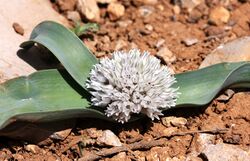Biology:Allium libani
| Lebanese garlic | |
|---|---|

| |
| Scientific classification | |
| Kingdom: | Plantae |
| Clade: | Tracheophytes |
| Clade: | Angiosperms |
| Clade: | Monocots |
| Order: | Asparagales |
| Family: | Amaryllidaceae |
| Subfamily: | Allioideae |
| Genus: | Allium |
| Subgenus: | Allium subg. Melanocrommyum |
| Species: | A. libani
|
| Binomial name | |
| Allium libani Boiss.
| |
Allium libani (Lebanese garlic ثوم لبناني ) is a species of wild bulbous plant geophyte of the genus Allium, belonging to the family of Amaryllidaceae. Allium libani is endemic to the Middle East in Lebanon and Syria.[2][3]
Taxonomy
Allium libani was described by Pierre Edmond Boissier and published in Diagnoses plantarum orientalium novarum 13: 26, in 1854.[4][5][6]
Etymology
- Allium
- old generic name. The plants of this genus were known by both the Romans as the Ancient Greece s . However, it seems that the term has an origin in Celtic which means "to burn", referring to the strong pungent smell of the plant. One of the first to use this name for botanical purposes was the French naturalist Joseph Pitton de Tournefort (1656 - 1708).[7]
- libani
- epithet, refers to its geographic location in Lebanon.[7]
Description
Allium libani is deciduous. The simple leaves are basal. They are broadly linear with entire margins and parallel venation. The scape characteristic of the family is essentially absent, so the umbel appears to be formed at ground level The flowers of Allium libani are white. Fruits are loculicidal capsules.[8]
Cultivation
The plants prefer a sunny situation on dry to moderately moist soil. The substrate should be sandy-loamy, gritty-loamy or sandy clay soil. They tolerate temperatures down to -7 °C
References
- ↑ Semaan, M. (2017). "Allium libani". IUCN Red List of Threatened Species 2017: e.T13144552A18613051. doi:10.2305/IUCN.UK.2017-3.RLTS.T13144552A18613051.en. https://www.iucnredlist.org/species/13144552/18613051. Retrieved 19 November 2021.
- ↑ "Allium libani Boiss. (accepted name)". Catalogue of Life. 15 August 2013. http://www.catalogueoflife.org/col/details/species/id/9763738. Retrieved 28 August 2013.
- ↑ "Flora of Israel Online". http://flora.huji.ac.il/browse.asp?action=specie&specie=ALLLIB.
- ↑ Missouri Botanical Garden. "Allium libani Boiss.". Tropicos.org. Missouri Botanical Garden. http://www.tropicos.org/Name/100144220. Retrieved 28 August 2013.
- ↑ Board of Trustees of the Royal Botanic Gardens, Kew. "Allium libani Boiss., Diagn. Pl. Orient. 13: 26 (1854).". World Checklist of Selected Plant Families. Royal Botanic Gardens, Kew. http://apps.kew.org/wcsp/namedetail.do?name_id=295898. Retrieved 28 August 2013.
- ↑ "Allium libani Boiss.". World Checklist of Selected Plant Families (WCSP). Royal Botanic Gardens (Kew). http://www.theplantlist.org/tpl1.1/record/kew-295898. Retrieved 2 August 2013.
- ↑ 7.0 7.1 Giacomo Nicolini, Enciclopedia Botanica Motta. Volume one, Milan, Federico Motta Editore, 1960, p. 76.
- ↑ "Allium libani". rareplants.co.uk/. http://rareplants.co.uk/product.asp?P_ID=2878&strPageHistory=related. Retrieved 28 August 2013.
Wikidata ☰ Q2919933 entry
 |


